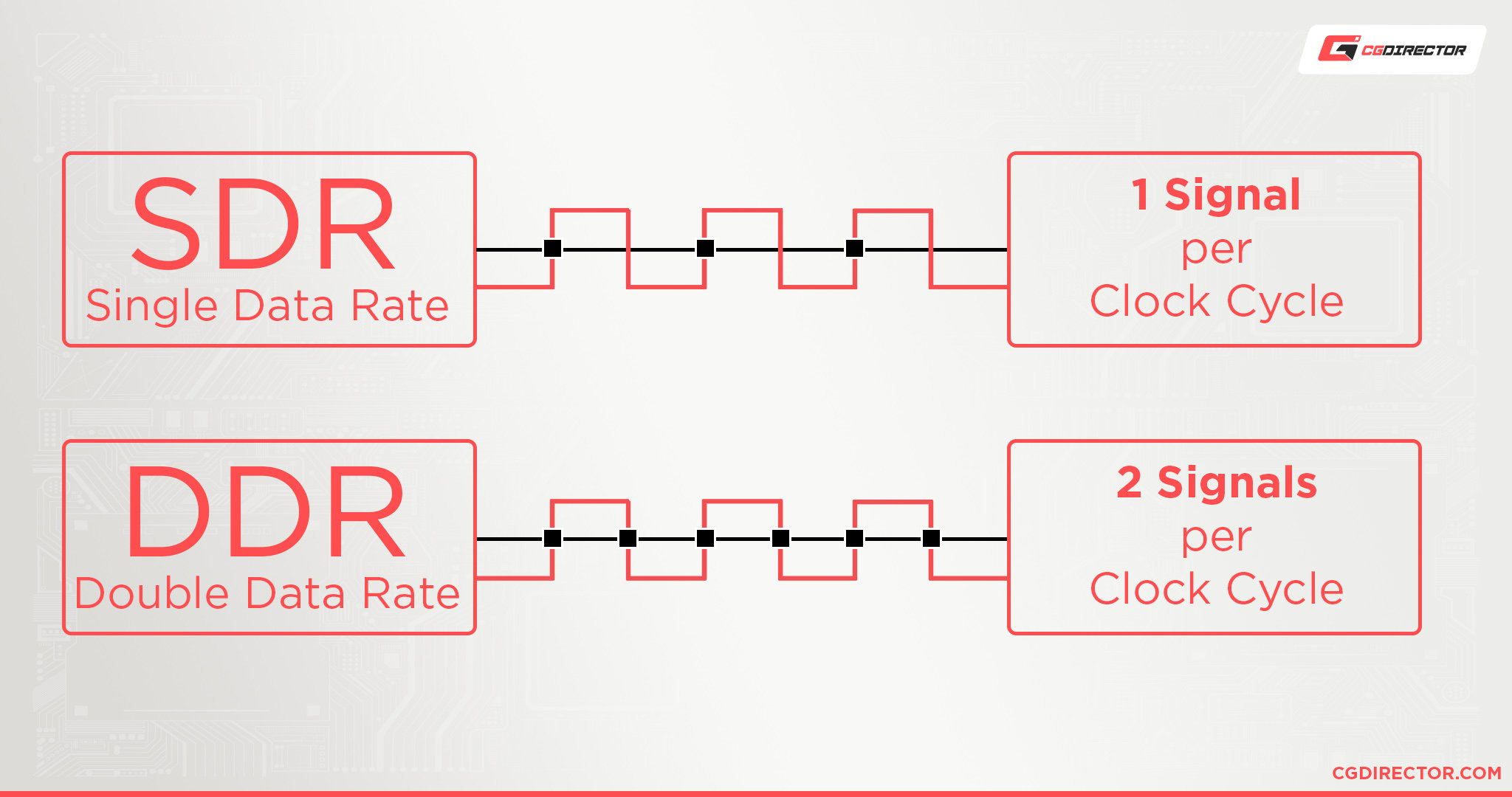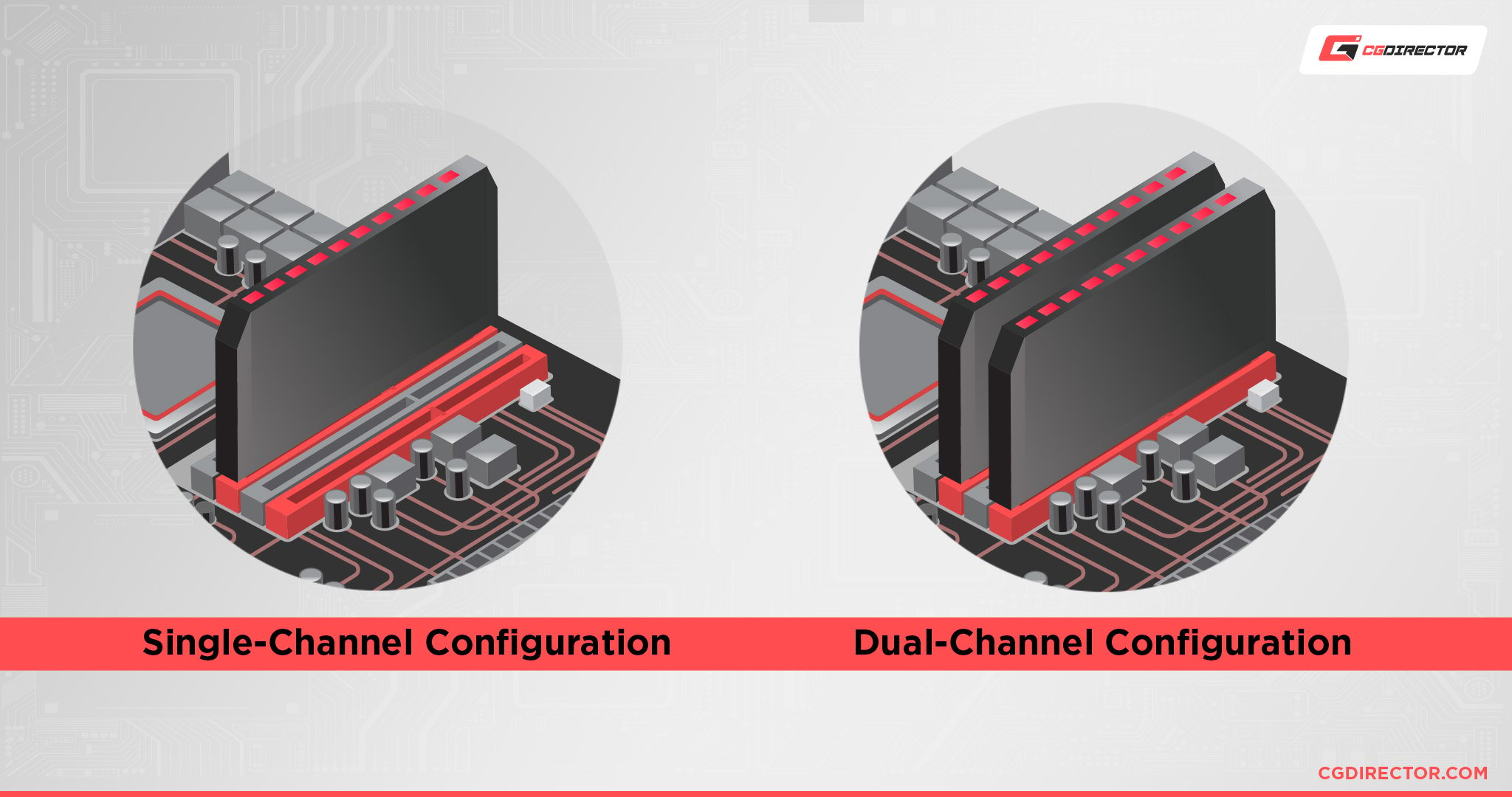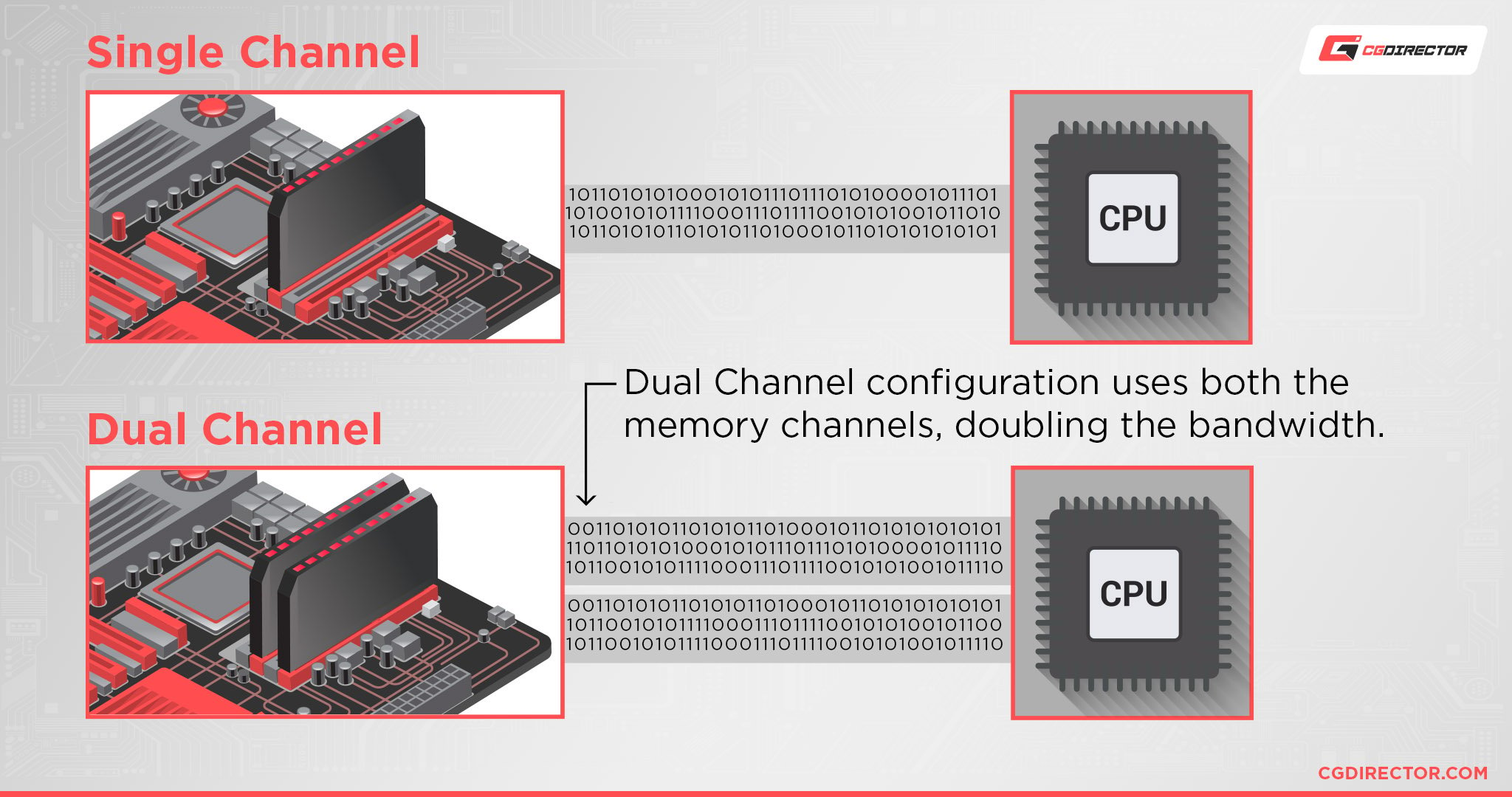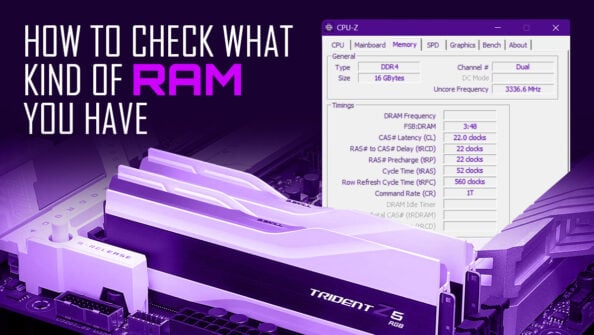TABLE OF CONTENTS
In the battle of Single Channel vs Dual Channel RAM, which comes out on top?
More importantly, why does it come out on top, and how does it actually impact your end-user experience?
I’ll be walking you through all of that in this article to the best of my ability, as well as closely-related questions you may want to know.
For now, let’s get into it.
A Brief on RAM and RAM Channels
So RAM, or Random Access Memory, serves as a real-time cache for the applications running on your CPU.
VRAM, or Video Random Access memory, does the same for GPUs.
Modern RAM is called DDR SDRAM. That’s, Double Data Rate Synchronous Dynamic Random Access Memory, or DDR SDRAM. Also, I’m never typing that again.

However, the secrets to DDR (SD)RAM are actually tied into that naming. Especially that “Synchronous” part.
The advertised boon of SDRAM is its ability to sync up with the system clock to achieve higher speeds and throughput than asynchronous RAM at least in theory. But there’s more to that than I can cover here.
For now, let’s define Single Channel and Dual Channel RAM.
Single Channel RAM describes any configuration where your CPU has access to a single 64-bit wide bus (in DDR4) to access memory. Modern desktop CPU memory controllers almost always support dual-channel memory today, so a single channel tends to become a case where you’ve installed a single stick of memory in your system.
Dual channel, on the other hand, refers to configurations where a CPU has access to two independent 64-bit wide buses when accessing memory space.

Two identical RAM sticks mounted properly (usually in color-coded pair of slots) will run in a Dual Channel configuration, which allows for double the memory throughput. Keep in mind, the number of channels is a CPU and motherboard limitation, so adding additional memory may or may not give you more channels depending on what platform you’re using.
More on how that actually works in the “Speed & Throughput” section!
Single Channel vs Dual Channel RAM: Cost for Capacity
This is the first and most obvious basis with which to compare Single Channel and Dual Channel RAM.
In raw materials, Dual Channel RAM will always be more expensive to produce, since it requires two sticks of memory rather than just one.
That being said, if you started with a Single Channel RAM stick and later added an identical one, you would then be running in Dual Channel- so it’s not like a permanent choice between one or the other (although not buying RAM in a KIT can complicate things in terms of compatibility).
The winner is Single Channel, by a thin margin.
Single Channel vs Dual Channel RAM: Speed & Throughput
Although both single and dual-channel memory will run at whatever speeds the modules are rated at (unless you’re mixing different modules, which is usually not a great idea), throughput is a different story.

Since dual-channel memory grants a CPU’s memory controller double the access ‘paths,’ the total memory throughput doubles.
When it comes to throughput, single-channel memory stands far behind dual-channel memory. However, theoretical speeds and practical speeds aren’t the same. If the applications or games you use don’t leverage more than a single channel effectively, the performance gains you see when hopping to dual-channel memory from a single channel could be negligible, or even non-existent!
That said, the data rates of each module (and their frequencies) remain identical between both memory configurations. If you’re interested in learning more about memory channels, the good ‘ol Ryzen memory guide has some useful tidbits.
Single Channel vs Dual Channel RAM: Gaming Performance
So, how do Single Channel and Dual Channel RAM configurations stack up in games?
Historically, not very well. Most older games didn’t need the additional bandwidth offered by Dual Channel RAM, and thus failed to use it effectively.
With the rise of modern game engines, however, this has now started to change.
Modern game engines are capable of leveraging a CPU’s resources much more thoroughly and intensively – more often than not, scaling across multiple cores. And with multiple CPU Cores needing access to your RAM, multiple channels come in handy.
This also makes modern games more sensitive to unexpected bottlenecks than old games used to be, and yes- this manifests in a tangible decrease in performance for Single Channel users.

Image Credit: Hardware Times’ Single Channel Benchmark

Image Credit: Hardware Times’ Dual Channel Benchmark
As documented by Areej, writing for Hardware Times, a number of modern games simply perform far worse in average FPS with a Single Channel configuration.
Even if the games seem to be running at around the same average, the Single Channel configurations consistently saw much worse 1% and 0.1% lows, which means that drops in framerate were frequent and severe.
Dual-Channel would improve these numbers massively, even in scenarios where the averages did not improve.

Image Credit: Hardware Times
So at least for gaming, it would seem that Dual Channel RAM provides more consistent baseline performance overall, but only offers an average FPS improvement in specific titles.
The titles that do seem reliant on Dual Channel configurations will heavily favor them for average FPS, though (like Assassin’s Creed Origins above).
Many games also seemed to care more about RAM speed than configuration, making it possible for a Single-Channel 3600 MHz RAM stick to beat slower Dual Channel competitors in certain scenarios.
Single Channel vs Dual Channel RAM: Rendering and Productivity Performance
So, what about rendering and productivity performance?
Truthfully, the results can massively vary- from almost no difference at all to major differences with certain workloads.
As tested by GamersNexus back in 2014, though, there are times when you can see some minor benefits from switching to Dual Channel.

Image Credit: GamersNexus

Image Credit: GamersNexus
So it seems that for things like video encoding and real-time previews during video editing, upgrading to Dual Channel can give you a roughly 5-6% bump in your performance. You can’t necessarily expect this to carry across all workloads, though.
Now, this doesn’t mean that there isn’t value in improving your channel configuration in general- there probably is- but this also goes to show just how often changes to RAM won’t matter until it’s actively bottlenecking you.
In general, I would veer on the side of Dual Channel or higher for professional workloads, especially those involving managing lots of big files (video editing, conversion, etc) and running multi-core optimized workloads.
CPU Cores that have to access your RAM at the same time can do so through multiple channels. Two Cores at once through dual-channel, four cores at once through quad-channel, and so on.
Do note, that for quad Channel you’ll need a Motherboard that supports this. Just because you have 4 RAM Modules doesn’t mean they’ll run in quad-channel mode. The same is true for Hexa or Octa channel on higher-end Motherboards.
Single Channel vs Dual Channel RAM: Conclusion
Well, now you understand the difference between how Single Channel and Dual Channel RAM kits work.
Dual-Channel is pretty much always better, but having 1 instead of 2 RAM sticks isn’t the worst thing that can happen to you.
When picking RAM Modules, here’s a list of factors that’ll impact your PC’s performance, from most important to least:
- Capacity (in GBytes, higher is better)
- Matching RAM (Buy RAM in a KIT)
- Channels (Single, Dual, Quad, Hexa, Octa, Higher is better)
- Frequency (The higher, the better)
- Latency (e.g., CAS Latency, the lower, the better)
- Ranks (Single, Dual, Quad Ranks, depending on your use case, usually higher is better)
- Brand (e.g., Corsair, G.Skill)
- Sides (Double / Single Sided, depends on your use case, single is generally better for lower temps)
FAQ
What should RAM Frequency be set to?
Probably whatever number is on the box, through enabling XMP or your AMD equivalent in your motherboard’s BIOs.
If you don’t know what any of that means, XMP refers to Xtreme Memory Profiles for Intel CPUs (AMD’s equivalent is called eXPO).
These store clock rates for the memory onboard and are activated through the BIOS, enabling the RAM’s rated speed…unless you have to tweak it, which you might.
A good place to start with XMP profiles would be Jerry’s Guide to Setting XMP Profiles!
Is DDR5 Better Than DDR4 RAM?
Uh, yes and no.
As DDR5 tech evolves, it may become a more compelling option over DDR4, especially as CAS Latencies are reduced and speeds continue to increase.
However, as explained by Jerry, the performance gap usually doesn’t justify the price gulf. Still, DDR5 memory has come down in price and can now be an option for professionals looking to build a ‘next-gen’ workstation. For gamers, the answer is still a big fat nope.
If you want some high-performance RAM that actually might be worth the money- especially if you’re using a Ryzen CPU and are a gamer or overclocker- consider checking out some Samsung B-Die RAM kits.
B-Dies offer superb low latency and pretty good speeds, making them an ideal companion to a gamer or overclocker’s PC build. It may be limited to DDR4, but the improvements in latency will give you better results for the money, especially in games.
Over to You
And that’s it, at least for now! I hope that this article helped you come to a better understanding of what Single Channel and Dual Channel are, and how you can expect them to impact your experience.
Leave a comment below and let me know if you have any lingering questions, or head to the forums with anything else you might need!
![Single Channel vs Dual Channel RAM [+Performance Compared] Single Channel vs Dual Channel RAM [+Performance Compared]](https://www.cgdirector.com/wp-content/uploads/media/2022/05/Single-Channel-vs-Dual-Channel-RAM-Twitter-1200x675.jpg)



![How Much RAM Does my PC Support? [How to Check] How Much RAM Does my PC Support? [How to Check]](https://www.cgdirector.com/wp-content/uploads/media/2023/10/How-Much-RAM-Can-My-Computer-Take-Twitter-594x335.jpg)

3 Comments
25 June, 2024
Is more cores with single memory channel better than less cores with dual memory channel ?
6 January, 2023
Dear Christopher,
maybe you should revise your article again, because it contains errors and is simply wrong in the crucial places.
DDR-SDRAM stands for ‘synchronous dynamic random-access memory’, you forgot the ‘dynamic’ (I know, small detail).
But the big error is your single/dual channel explanation. The advertised doubling of the ram clock frequency comes from the double in DDR as opposed to single in SDR SDRAM (single data rate …), the former standard for working memory. The DDR type of RAM transports two dates in a single clock cycle, thus doubling the effective data rate. This is exactly what the linked article from Jerry James explains. This has nothing to do with a single/dual or even quad channel configuration. The advertised data rate for a quad-channel kit will also be 4200 MHz/MT and not, after the logic of your article, 8400 MHz/MT.
Regards, Uli.
P.S. I’m not a native speaker, so please excuse my spelling mistakes.
8 January, 2023
Hey Uli, thanks for the heads up! Really appreciate it.
The information in the article is fixed now 🙂
Cheers!
Jerry